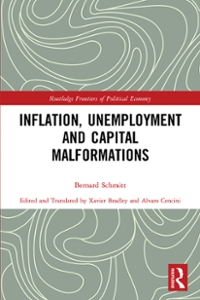6 (1) Show that in a one-step binomial tree model of the price of a non-dividend-paying share, the risk-neutral probability q of an up movement is given by: prot -d u-d where d , u, r and ot are quantities you should define. (ii) Explain briefly why it must be assumed that d q if and only if 1+ 0>e" and interpret this result. 7 The movement of a share price over the next two months is to be modelled using a two-period recombining binomial model. Over each month, it is assumed that the share price will either increase or decrease by 10%. (i) Over each month, the risk-neutral probability of an up-step is q=0.55. Calculate the monthly risk-free force of interest / that has been used to arrive at this figure. [1] (ii) The current share price is 1. The annualised expected force of return on the share is # =30%. Calculate the state-price deflators in each of the three possible final states of the share price. [4] (mii Calculate the value of each of the following two-month derivatives: (a) a derivative with payoff profile (1,0,0) (b) a derivative with payoff profile (0,1,0) (c) a derivative with payoff profile (0,0,1) (d) a European call option with a strike price of K =0.95 (e) a European put option with a strike price of K = 1.05 (f) a derivative whose payoff is 2x 5-0.98 , where $ is the share price at the end of the two months. [5] A payoff profile of (x, y,z) means that the derivative returns x if the share price goes up twice, y if the share price goes up once and down once, and z if the share price goes down twice. [Total 10].4 ne form of the Black-Scholes partial differential equation Is: H+rsd+liozszr = pf Ill} State the context in which this formula applies, indicating what s and I represent. {You are not required to state the Black-Scholes assu motions] {Ii} What do r and or represent? What assumptions are made about these quantities in this equation? Iliii} State the names and give the mathematical denitions of the \"E reeks' that appear in this equation. liv} What boundary condition would you need to use in order to solve this equation when applied to a European call option with a strike price it ? .5 An investor buys, for a premium of 13105, a call option on a non-dividend-paving stock whose I current price is ifl The strike price of the call is 5,150 and the time to e: piry is 5 months. The riskvfree rate of return is 5% pa continuously compounded. The BIack-Soholes formula for the price of a call option on a non-dividendvpaying share is assumed to hold. Ii} Calculate the price of a put option with the same time to maturity and strike price as the call. [1] {ii} The Investor buys a put option with strike prloe 4J5: with the same time to maturity. Calculate the price of the put option if the implied volatility were the same as that in (ii. [You need to estimate the implied volatility to within 156 pa oi the correct value] [T] [Total 9]








